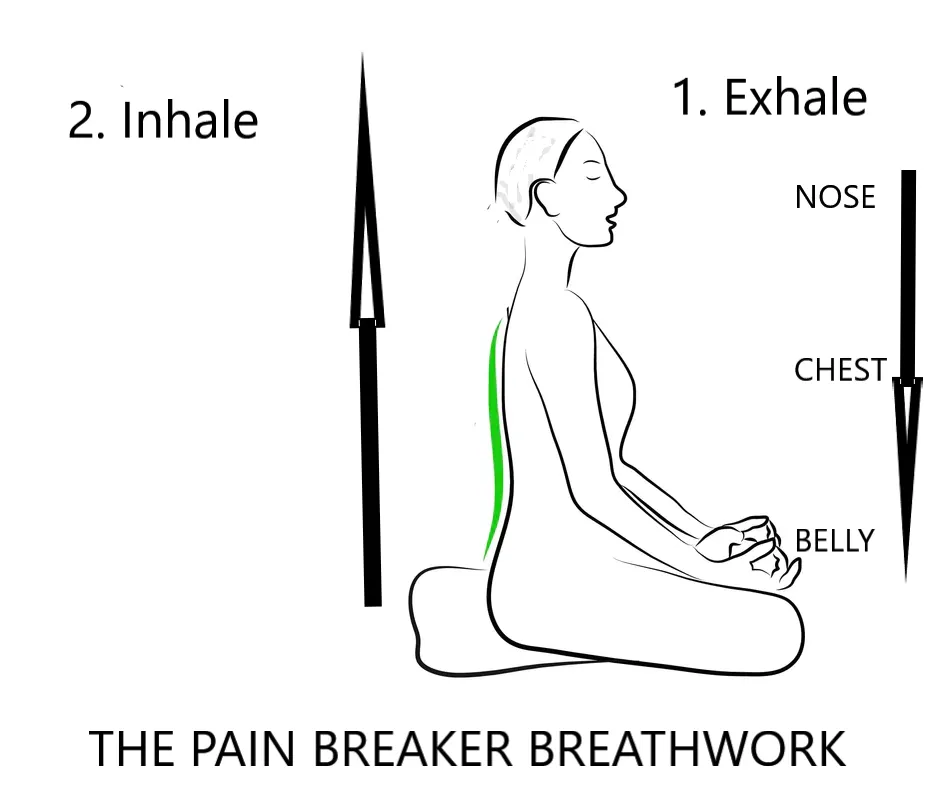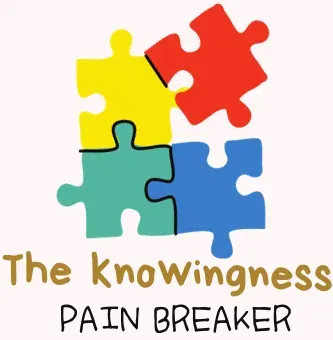
The Pain Breaker’s Methods
Welcome to this guide, which is designed to prepare your mind and body for calm detachment from unwanted patterns of overthinking. This guided meditation aims to encourage a quiet awareness of the breath and a gentle detachment from rumination habits.
Additionally, this session will help alleviate the symptoms of depression, OCD, and anxiety. By practicing these pain-breaker methods of mindfulness, self-acceptance, and conscious awareness, you will find you can relax and quiet an overly active mind.
So, without further ado, let’s get started!
1. Yoga & Mindfulness Based: Pain Management Breathwork
Yoga & Mindfulness-Based: Pain Management Breathing Method is a mindfulness-based intervention. The method provides specific applications for people with chronic pain and illness by using the prime concepts and techniques of mindfulness-based stress reduction (MBSR) and mindfulness-based cognitive therapy (MBCT).
This pain breaker method is a secular practice developed by JJ Mok, the founder of The Knowingness Pain Breaker and is delivered through his Breathwork programs.
Several clinical studies unveil the effectiveness of this breathwork. The method is derived from Patanjali Yoga Sutra and The Yellow Emperor Medical Sutra as Prana or Qi, the material basis and power source of human life activities. Also, it is the key to disease resistance, immunity, fitness and longevity.
The Prana is the meridian Prana. Therefore, if Prana is sufficient, the body will be healthy. In contrast, if Prana is insufficient, various diseases will occur, and if Prana disappears, life will end.
The Prime Concept of Pain Management Breathwork
The core of the Pain Management Breathwork is to use five-step exercises to allow people to follow their awareness, adjust their breathing, cultivate Prana, and penetrate the meridians.
Furthermore, the five-step exercises explore the inherent potential of the human body and exert self-regulation and self-healing. Also, a series of functions such as self-treatment and self-reconstruction achieve the effect of disease prevention and pain relief.
Essential Steps for Pain Management Breathwork
The regulation of Prana is the method through which the practitioners harness all the energy from the entirety of the universal and strive to detach all the suffering and pains from the body.
The method is divided into five steps:
Step 1: Look at the tip of your nose, then pay attention to the pit of your chest for a few minutes.
Step 2: Exhale and follow the awareness, looking down on the way to the belly.
Step 3: At the end of the exhale, hold your breath for a few seconds and pay attention at the turn of the inhale, which is the inhale of Prana energy from the belly. If you pay attention, it is energy; if you do not consider it, it’s nothing more than air.
Step 4: Let the Prana energy from the belly flow through the back of the body freely.
Step 5: To accumulate energy and vitality, at the end of inhale, hold your breath for a few seconds and feel the blissfulness of Prana energy. Then, merge with the Prana energy from the cosmic presence at the top of the head.
Pay attention at the turn of the exhale and continue 2nd step.
Requirements for facial features
This five-step breathwork puts the following conditions on your facial features:
● Oral Cavity
During exhale, roll the tongue up to about 90 degrees and gently touch the upper palate with the tip of the tongue. Put your tongue down, swallow slowly, and continue if saliva is secreted.
● Eyes
Half close your eyes slightly like curtains, letting out a glimmer of light. Then, gently look at the tip of your nose, be introverted, and calm your mind.
● Ears
Pay attention to your breathing with both ears so it does not make a rough sound. Plus, keep it calm and slow. This is an excellent way to slow your thoughts.
Respiratory requirements
Since Prana breathing is the driving force for the movement of vital energy, one breathes in and out through the nose. In the entire five-step exercise, you only pay attention to exhalation, do not worry about inhalation, and let it happen naturally.
Guidelines for Drinking Water
You have to follow the following guidelines for drinking water to get the desired results:
1. After Waking Up till Lunch
Sip only one glass of warm water with some ginger powder till lunchtime. Take your breakfast at least half an hour after the first water intake, and take half a cup of black tea/hot coffee if you insist during breakfast. Take three sips of water every 20 minutes.
2. After Lunch
Drink one glass of warm water an hour after a meal to improve digestion. Be sure not to drink too soon before or after a meal because water will dilute the digestive fluid.
3. After Lunch till Dinner
Sip 4 glasses of warm water. Three sips of water every 20 minutes.
4. After Dinner
Drink one glass of warm water an hour after a meal to improve digestion. Remember not to drink too soon before or after a meal because the water will dilute the digestive fluid. Eat half the portion of meal compared to lunch or skip dinner at all.
5. Before a Bath
Sip one glass of water before and after a bath to help lower your blood pressure.
6. Before Sleep
Sip half a glass of water an hour before bedtime to replenish fluid loss during the night.
2. Detached Mindfulness Exercise to Detach Pain and Insomnia
Detached mindfulness is a popular mind-work of being aware of thoughts in the mind and doing nothing to them. It does not mean grabbing; instead, it revolves around detachedly awareness of the thought and pushing it away.
Detached Mindfulness
Imagine a worry trigger like “What if I perform poorly at my work?” pops into your mind. If you are responding creatively and engaging in attempts to cope with this thought, you might follow the thought down the rabbit hole and go on thinking like:
“I’ll be fired…
I won’t be able to pay my mortgage…
I’ll lose my house…”,
Then, you imagine a future scenario in which you are sleeping by the roadside… and your enemy sees you eating by the roadside…
You attempt to control your thoughts by thinking only positive aspects, but too bad, most of your negative thoughts overcome you.
However, if you respond to this same thought using Detached Mindfulness, you might observe the initial triggering thought and step back from it in your mind.
Set yourself apart from that thought by noticing where you are concerning it and observing it detachedly, allowing it to come and go on its own, like clouds passing in the sky.
Or you should step back with the response by saying “OH” after each thought and make sure you can listen to the “OH.”
After a detached mindfulness exercise, your metacognitive beliefs will slowly change from “I can’t stop rumination/overthinking” to “I’m in full control of my thinking.”
You need Prana energy to be able to perform the detachment, and this energy is free of charge.
Wrapping Up!
Yoga and mindfulness-based approaches incorporate breathwork as the key elements ideal for pain management. This practice involves the MBCT techniques to improve awareness, relaxation, and overall wellness.
Moreover, detached mindfulness therapy is a do-nothing strategy for negative feelings and thoughts. This practice is effective in reducing rumination and depressive symptoms.
DISCLAIMER: The medical information on this site is provided as an information resource only, and is not to be used or relied on for any diagnostic or treatment purposes. This information is not intended to be patient education, does not create any patient-physician relationship, and should not be used as a substitute for professional diagnosis and treatment.
ADDRESS
7 Temasek Boulevard
#12-07 Suntec Tower One
Singapore 038987
1-13A-07 Aurora Sovo
No.1, Persiaran Jalil 1 Bandar Bukit Jalil,
Kuala Lumpur
Malaysia 570000
Tesla Wave distributor
408A Fernvale Poad Coral Spring
Singapore 791408
© 2023 Pain Breaker. All Rights Reserved
